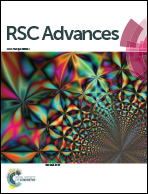Controllable synthesis of Pd@ZIF-L catalysts by an assembly method†
Abstract
The Pd@ZIF-L catalysts with uniform crosshair-star shape and a size of about 20 μm were fabricated by an assembly method that enables the crystallization of ZIF-L in water with the presence of polyvinylpyrrolidone (PVP)-stabilized Pd nanoparticles (NPs). The physical and catalytic properties of the Pd@ZIF-L catalysts are greatly affected by the molar ratios of 2-methylimidazole (2-MeIM)/Zn2+ and PVP/Zn2+. Their catalytic activities were evaluated by the catalytic reduction of p-nitrophenol to p-aminophenol. The results indicate that a lower molar ratio of 2-MeIM/Zn2+ is beneficial for the increase of Pd loading and p-nitrophenol conversion, but a suitable molar ratio (≥20) of 2-MeIM/Zn2+ is helpful to the crystallization of ZIF-L and the encapsulation of the Pd NPs within the ZIF-L framework. The Pd@ZIF-L catalyst synthesized at a lower PVP/Zn2+ molar ratio has higher Pd loading and p-nitrophenol conversion due to the easy adsorption of PVP–Pd NPs onto the ZIF-L surfaces. This work would aid the development of high-performance Pd@ZIF-L catalysts.


 Please wait while we load your content...
Please wait while we load your content...